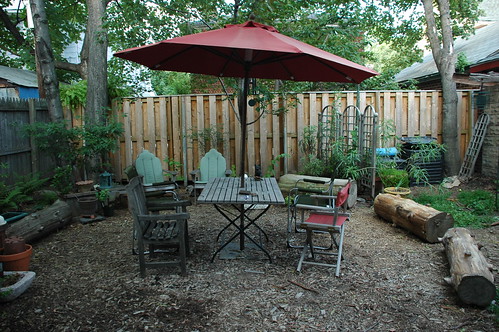Today on Brownstoner there’s a post and extended commentary (as one expects at the ‘Stoner) about the garden design for a multi-unit residential Project in Gowanus called Third & Bond (presumably located there):
Now that our building design is nearly complete, we’ve turned our attention to what surrounds the buildings: the outdoors. Third & Bond has 38 private outdoor spaces (enough for 85% of buyers to have their own) as well as 7 front yards and a courtyard. We want these spaces to look great, be easy to maintain, and meet our “green” goals. In short, we needed a green landscaping genius.
They choice local garden designer Timothy D. Osborne, who does business as The Organic Gardener. They promise to share “the actual designs in the coming weeks.” In today’s post they describe some design constraints dear to my heart: grass-less (meaning no lawn), native plants and local materials, and butterflies. Some of the points are a bit confused, but the intent is sound.
Grass is a LEED [Leadership in Energy and Environmental Design] no-no. Lawn grasses like crab grass and Kentucky blue grass are not native to North America and require a tremendous amount of watering compared with native coastal grasses.
I just checked the LEED Version 2.2 Rating System and Credit Checklist for New Construction and didn’t find any references to lawn or grass. Still, eliminating lawn is a brave choice for a developer; I’m surprised and pleased to hear they’re going to try to make it work.
Since we bought our house some 30 months ago, I’ve been gradually reducing the garden space devoted to lawn. I have a small patch of lawn left in the front yard. We no longer use a lawn care service; they all use gas-powered mowers and leaf-blowers, which pound-for-pound are worse than SUVs for their carbon emissions, particulate pollutants, and noise pollution. I use a push-reel mower and rake. I rarely water, and it shows. I’ve seen some beautiful examples of lawn-less front-yard gardens in the area. I expect that within a few years what’s left of our lawn will be replaced with more complex, interesting, and sustainable plantings.
The Organic Gardener’s plant suggestions were almost all native including lavender and dogwood.
Lavender is not native to North America, but it’s a great choice for xeriscaping, low-water-use gardening.
Satisfying the local butterfly population is pretty much our #1 priority at Third & Bond. But seriously, another benefit to choosing local plants is that they are more attractive to birds and butterflies native to the area. We’re hoping our plant materials will be especially attractive to winged wildlife.
If they can follow through with these intentions, I have no doubt they will be.
Although I write about local issues, and go so far as to dive into zoning and land use, I avoid the hard-core, snipe and snark, body-slam arena of Brooklyn real-estate blogging. There’s not much opportunity to return the link-love I get now and then from Brownstoner. It’s nice to be able to return the favor while staying on-point for this blog.
Related Posts
Front garden
Native plants
Sustainability
Mowing the Lawn, June 6, 2006
Links
Third & Bond: Week 17, Brownstoner
The Organic Gardener, Timothy D. Osborne (Note: His Web site is poorly designed. All the information exists only as graphics. Even the menus are available only as image maps, with no labels. There’s no text anywhere on the site.)
Leadership in Energy and Environmental Design (LEED), U. S. Green Building Council











 1 & 2 Family Residential
1 & 2 Family Residential Multi-family Residential (3 or more Residential Units)
Multi-family Residential (3 or more Residential Units) Mixed Use (Residential and Commercial)
Mixed Use (Residential and Commercial) Commercial
Commercial Institutions
Institutions Transportation & Parking
Transportation & Parking Industrial (corresponds to Zoning’s “Manufacturing” designation)
Industrial (corresponds to Zoning’s “Manufacturing” designation) Vacant Lots
Vacant Lots































